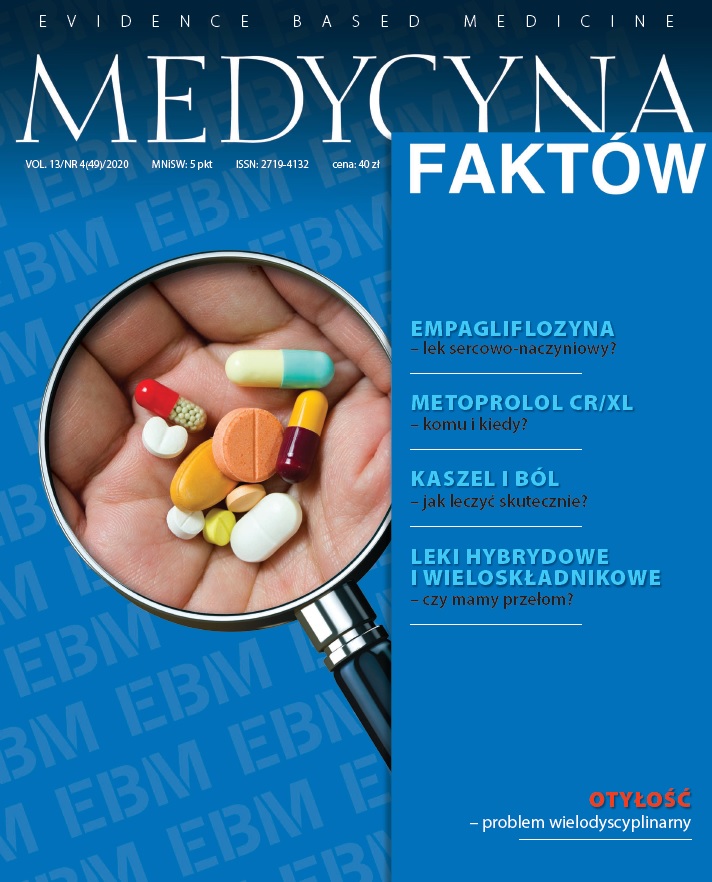The use of pantoprazole and famotidine in gastroesophageal reflux disease Case report
Main Article Content
Abstract
Gastroesophageal reflux disease is one of the most common diseases of the gastrointestinal tract, the incidence is comparable in men and women and increases with age (especially after the age of 40). The essence of the disease is the reflux of acid gastric contents into the lumen of the esophagus and causing local irritation of the mucosa. The main symptom of gastroesophageal reflux disease is heartburn, i.e. a burning sensation behind the breastbone, often aggravated after a heavy and fatty meal or a change in body position (by bending down, lying down). Symptoms, including extra-esophageal symptoms, can also occur at night (even in 45–80% of gastroesophageal reflux disease patients) and are not always immediately associated with reflux. The mainstay of treatment are acid-inhibiting drugs. The purpose of this article is to discuss, on a case-by-case basis, the beneficial combination of pantoprazole with famotidine for symptom control and quality of life improvement.
Article Details
Copyright © by Medical Education. All rights reserved.
References
2. Vakil N, van Zanten SV, Kahrilas P et al. The Montreal definition and classification of gastroesophageal reflux disease: a global evidence-based consensus. Am J Gastroenterol. 2006; 101: 1900-20.
3. Lundell L, Dent J, Bennett J et al. Endoscopic assessment of oesophagitis: clinical and functional correlates and further validation of the Los Angeles classification. Gut. 1999; 45: 172-80.
4. Jones RH, Hungrin ADS, Philips J. Gastroesophageal reflux disease in primary care in Europe: clinical presentation and endoscopic findings. Eur J Gen Pract. 1995; 1: 149-54.
5. Bodger K, Trudgill N. Guidelines for oesophageal manometry and pH monitoring. BSG, London 2006.
6. Ness-Jensen E, Hveem K, El-Serag H et al. Lifestyle intervention in gastroesophageal reflux disease. Clin Gastroenterol Hepatol. 2016; 14: 175-82.
7. Ambrecht U, Abucar A, Hameeteman W et al. Treatment of reflux oesophagitis of moderate and severe grade with ranitidine or pantoprazole – comparison of 24-hour intragastric and oesophageal pH. Aliment Pharmacol Ther. 1997; 11(5): 959-65.
8. Wedemeyer R-S, Blume H. Pharmacokinetic drug interaction profiles of proton pump inhibitors: an update. Drug Saf. 2014; 37: 201-11.
9. Shi S, Klotz U. Proton pump inhibitors: an update of their clinical use and pharmacokinetics. Eur J Clin Pharmacol. 2008; 64: 935-51.
10. Gerson LB, Triadafilopoulos G. Proton pump inhibitors and their drug interactions: an evidence-based approach. Eur J Gastroenterol Hepatol. 2001; 13: 611-6.
11. Dąbrowski A, Štabuc B, Lazebnik L. Meta-analysis of the efficacy and safety of pantoprazole in the treatment and symptom relief of patients with gastroesophageal reflux disease – PAN-STAR. Prz Gastroenterol. 2018; 13(1): 6-15.
12. Mainie I, Tutuian R, Castell DO. Addition of a H2 receptor antagonist to PPI improves acid control and decreases nocturnal acid breakthrough. J Clin Gastroenterol. 2008; 42(6): 676-9.
13. Echizen H, Ishizaki T. Clinical pharmacokinetics of famotidine. Clin Pharmacokinet. 1991; 21(3): 178-94.
14. Rackoff A, Agrawal A, Hila I et al. Histamine-2 receptor antagonists at night improve gastroesophageal reflux disease symptoms for patients on proton pump inhibitor therapy. Dis Esophagus. 2005; 18: 370-3.
15. Tutuian R, Castell DO. Nocturnal acid breakthrough – approach to management. MedGenMed. 2004; 6(4): 11.

